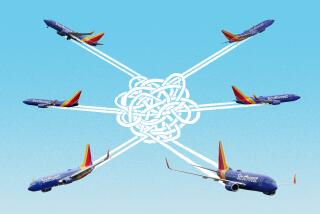Earnings Soar at Southwest and American
Higher fares and crowded airplanes helped Southwest Airlines Co. and the parent of American Airlines post sharply higher second-quarter profits Wednesday despite record jet fuel prices.
Southwest and American are the first big carriers to report second-quarter results, and Wall Street was watching for signs that the industry had regained its financial footing after years of poor performance and, more recently, skyrocketing fuel costs.
“I think they are going to be strong across the board,” analyst Ray Neidl of Calyon Securities said of airlines’ second-quarter results. “It looks like they’ve turned the corner if oil prices don’t continue to rise.”
American parent AMR Corp. reported net income of $291 million, or $1.14 a share, for the three months ended June 30, a fivefold increase from $58 million, or 30 cents, in the same period last year. Revenue rose 12.5% to $5.98 billion.
It was only the second time in the last 5 1/2 years that AMR had posted a quarterly profit without the aid of one-time gains, Chief Executive Gerard Arpey said. AMR has lost money in each of the last five years.
The results “demonstrate that we are on the right track toward returning our company to financial health,” Arpey said.
Fort Worth-based American, the biggest U.S. carrier in terms of passengers, benefited during the second quarter both from carrying more passengers per plane and from charging them more for the service.
The carrier’s load factor -- the percentage of seats sold -- hit a record 82.6%, in part because American reduced excess capacity by cutting flights in some markets. Its average ticket price increased 7.6% from a year earlier.
Those factors helped offset the additional $374 million the carrier paid for fuel compared with last year’s second quarter. Jet fuel was selling for $2.19 a gallon, not including taxes or delivery costs, on the spot market in Los Angeles this week, up from $1.70 a year ago and triple the price five years ago.
Noting that the second quarter is traditionally a strong one for airlines, Arpey cautioned that the outlook for the rest of the year remained “challenging,” particularly given the uncertain outlook for oil prices.
At Dallas-based Southwest, second-quarter income more than doubled to $333 million, or 40 cents a share, from $144 million, or 18 cents, a year earlier. Revenue rose 26% to $2.45 billion.
The airline should easily surpass its goal of 15% profit growth this year, Chief Executive Gary Kelly told analysts. He said Southwest expected to increase profit by the same amount next year and noted that the airline was in the market for used aircraft so that it could take advantage of expansion opportunities.
Southwest has avoided the stormy financial weather that hit American and most other carriers after the Sept. 11 terrorist attacks. One reason has been the carrier’s heavy use of hedging strategies to reduce fuel costs.
Hedging saved the airline $225 million on fuel purchases in the second quarter, when it paid an average of $1.42 a gallon for jet fuel. By contrast, American, which makes less use of hedging, paid an average of $2.10.
Southwest has joined other carriers in raising fares to offset fuel price increases. Kelly, mindful of Southwest’s status as the leading U.S. discount airline, noted that a Fourth of July fare increase that was widely reported affected only 20% of the carrier’s customers.
“We don’t want our company to get addicted to high fares,” Kelly said.
Even so, Southwest’s average ticket price increased almost 10% during the quarter. Kelly said the higher fares seemed to be affecting demand in a few markets, which he did not specify. Arpey said American had not experienced a similar effect on demand.
Kelly said it was too early to tell whether Southwest would abandon its open-seating policy. A test of assigned seating being conducted in San Diego has gone well, he said, but it is unclear whether customers want the change or how it would affect Southwest’s ability to get aircraft in and out of airports quickly.
Excluding gains from its hedging activities, Southwest earned $273 million, or 33 cents a share, in the second quarter. On that basis, Wall Street was forecasting results of 26 cents a share. The company’s stock climbed $1.30, or more than 8%, to $17.24.
Shares of AMR, whose results were in line with expectations, added 26 cents to $24.62.
American is the No. 2 airline at Los Angeles International Airport behind United Airlines in terms of boardings. Southwest ranks third.
More to Read
Inside the business of entertainment
The Wide Shot brings you news, analysis and insights on everything from streaming wars to production — and what it all means for the future.
You may occasionally receive promotional content from the Los Angeles Times.










